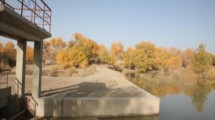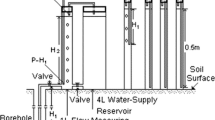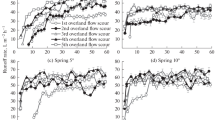Abstract
Soil structural disturbance influences the downward flow of water that percolates deep enough to become aquifer recharge. Data from identical experiments in an undisturbed silt-loam soil and in an adjacent simulated waste trench composed of the same soil material, but disturbed, included (1) laboratory- and field-measured unsaturated hydraulic properties and (2) field-measured transient water content profiles through 24 h of ponded infiltration and 75 d of redistribution. In undisturbed soil, wetting fronts were highly diffuse above 2 m depth, and did not go much deeper than 2 m. Darcian analysis suggests an average recharge rate less than 2 mm/year. In disturbed soil, wetting fronts were sharp and initial infiltration slower; water moved slowly below 2 m without obvious impediment. Richards’ equation simulations with realistic conditions predicted sharp wetting fronts, as observed for disturbed soil. Such simulations were adequate for undisturbed soil only if started from a post-initial moisture distribution that included about 3 h of infiltration. These late-started simulations remained good, however, through the 76 d of data. Overall results suggest the net effect of soil disturbance, although it reduces preferential flow, may be to increase recharge by disrupting layer contrasts.
Résumé
La perturbation de la structure du sol influence l’écoulement vers le bas de l’eau qui percole assez loin en profondeur pour recharger les aquifères. Les données d’expériences identiques menées sur un sol non-perturbé silto-limoneux et sur une tranchée à déchets adjacente et composée du même type de sol, mais perturbé, incluent (1) les propriétés hydrauliques saturées et non-saturées mesurées en laboratoire et sur le terrain (2) des profils de saturation en eau issus de tests d’infiltration de 24 h et 75 j de redistribution. Dans les sols non-perturbés, le front d’humidification ont très diffus au-dessus de 2 mètres de profondeur, et ne vont pas plus loin que 2 m en profondeur. L’analyse darcienne suggère un taux de recharge moyen inférieur à 2 mm/an. Dans les sols perturbés, les fronts d’humidification sont angulaires et l’infiltration initiale moins importante, l’eau s’écoule lentement sous 2 mètres, sans empêchements. Les simulations de l’équation de Richards suivant des conditions réalistes prédit les fronts d’humidification angulaires, tels qu’observés dans les sols perturbés. De telles simulations ont été adéquates seulement si elles commencent après une distribution initiale correspondant à environ 3 h d’infiltration. Toutefois ces simulations aux conditions initiales retardées restent correctes sur les 76 j de données. Les résultats globaux suggèrent que la perturbation du sol, bien que réduisant l’écoulement préférentiel, est à même d’augmenter la recharge en cassant les contrastes entre les différentes couches.
Resumen
La alteración estructural del suelo influye en el flujo descendiente de agua que percola a suficiente profundidad para convertirse en la recarga del acuífero. Los datos de experimentos idénticos en un suelo franco-limoso sin alteración estructural, y en una trinchera adyacente con residuos simulados compuesta del mismo material de suelo, pero alterada, incluyó (1) mediciones de campo y laboratorio de propiedades hidráulicas no saturadas y (2) perfiles transitorios de contenido de agua medidos en el campo a través de infiltración estancada durante 24 h y 75 d de redistribución. En los suelos sin alteración los frentes de humedad fueron altamente difusos por encima de 2 m de profundidad, y no se extendieron a profundidades mayores de 2m. El análisis Darciano sugiere un ritmo de recarga promedio menor a 2 mm/año. En suelo alterado, los frentes de humedad fueron nítidos y la infiltración inicial más lenta; el agua se movió lentamente por debajo de 2m sin impedimento obvio. Las simulaciones en base a la Ecuación de Richards en condiciones realísticas predijeron nítidos frentes de humedad, como se observó en los suelos alterados. Tales simulaciones fueron adecuadas para suelos sin alteración solo si se comenzaron a partir de una distribución de humedad post-inicial que incluyó cerca de 3 h de infiltración. Estas simulaciones de iniciación tardía permanecieron buenas a través de los 76 d de datos. Los resultados globales sugieren que el efecto neto de la alteración del suelo, aunque reduce flujo preferencial, puede ser el incremento en recarga mediante la perturbación de contrastes de capas.













Similar content being viewed by others
References
Albright WH, Benson CH, Gee GW, Abichou T, McDonald EV, Tyler SW, Rock SA (2006a) Field performance of a compacted clay landfill final cover at a humid site. J Geotech Geoenviron Eng 132(11):1393–1402
Albright WH, Benson CH, Gee GW, Abichou T, Tyler SW, Rock SA (2006b) Field performance of three compacted clay landfill covers. Vadose Zone J 5(4):1157–1171. DOI 10.2136/vzj2005.0134. http://vzj.scijournals.org/cgi/content/abstract/5/4/1157
Allmaras RR, Rickman RW, Ekin LG, Kimball BA (1977) Chiseling influences on soil hydraulic properties. Soil Sci Soc Amer J 41:796–803
Allmaras RR, Ward K, Douglas CL, Ekin LG (1982) Long-term cultivation effects on hydraulic properties of a Walla Walla silt loam. Soil Tillage Res 2:265–279
Andraski BJ (1996) Properties and variability of soil and trench fill at an arid waste-burial site. Soil Sci Soc Amer J 60:54–66
Arkley RJ (1963) Calculation of carbonate and water movement in soil from climatic data. Soil Sci 96:239–248
Azooz RH, Arshad MA, Franzluebbers AJ (1996) Pore size distribution and hydraulic conductivity affected by tillage in northwestern Canada. Soil Sci Soc Am J 60:1197–1201
Baker DE, Ahern CR (1989) Estimates of effective rooting depth for predicting available water capacity of burdekin soils, Queensland. Aust J Soil Res 27(2):439–454
Bartholomay RC, Knobel LL, Davis LC (1989) Mineralogy and grain size of surficial sediment from the Big Lost River drainage and vicinity, with chemical and physical characteristics of geologic materials from selected sites at the Idaho National Engineering Laboratory, Idaho. US Geol Surv Open File Rep 89–384
Basile A, Ciollaro G, Coppola A (2003) Hysteresis in soil water characteristics as a key to interpreting comparisons of laboratory and field measured hydraulic properties. Water Resour Res 39(12), 1355. DOI 10.1029/2003WR002432
Bouma J, van Rooyen DJ, Hole FD (1975) Estimation of comparative water transmission in two pairs of adjacent virgin and cultivated pedons in Wisconsin. Geoderma 13:73–88
Cecil LD, Pittman JR, Beasley TM, Michel RL, Kubik PW, Sharma P, Fehn U, Gove HE (1992) Water infiltration rates in the unsaturated zone at the Idaho National Engineering Laboratory estimated from chlorine-36 and tritium profiles, and neutron logging. In: Kharaka Y, Maest A (eds) Water rock interaction. Balkema, Rotterdam, The Netherlands, pp 709–714
Chertkov VY, Ravina I (1998) Modeling the crack network of swelling clay soils. Soil Sci Soc Amer J 62(5):1162–1171
Constantz J, Herkelrath WN (1984) Submersible pressure outflow cell for measurement of soil water retention and diffusivity from 5 to 95°C. Soil Sci Soc Amer J 48(1):7–10
Davis LC, Pittman JR (1990) Hydrological, meteorological, and geohydrological data for an unsaturated zone study near the Radioactive Waste Management Complex, Idaho National Engineering Laboratory, Idaho-1987. US Geol Surv Open-File Rep 90–114
Doherty J, Brebber L, Whyte P (1994) PEST: model-independent parameter estimation. Watermark Computing, Oxley, Australia
Dunker RE, Hooks CL, Vance SL, Darmody RG (1995) Deep tillage effects on compacted surface-mined land. Soil Sci Soc Amer J 59(1):192–197
Gardner WR (1956) Calculation of capillary conductivity by the one-step method. Soil Sci Soc Amer Proc 20:317–320
Gee GW, Bauer A, Decker RS (1978) Physical analyses of overburden materials and mine land soils. In: Schaller FW, Sutton P (eds) Reclamation of drastically disturbed lands, 1st edn. American Society of Agronomy, Madison, WI, pp 665–686
Hamblin AP, Tennant D (1981) The influence of tillage on soil water behavior. Soil Sci 132(3):233–339
Hayashi Y, Kosugi K, Mizuyama T (2006) Changes in pore size distribution and hydraulic properties of forest soil resulting from structural development. J Hydrol 331:85–102
Healy RW (1990) Simulation of solute transport in variably saturated porous media with supplemental information on modifications to the U.S. Geological Survey’s computer program VS2D. US Geol Surv Water Resour Invest Rep 90–4025
Jayawardane NS, Prathapar SA (1992) Effect of soil loosening on the hydraulic properties of a duplex soil. Aust J Soil Res 30:959–975
Jenny H (1941) Factors of soil formation. McGraw-Hill, New York
Jenny H, Leonard CD (1939) Functional relationships between soil properties and rainfall. Soil Sci 38:363–381
Johnson CD, Skousen JG (1995) Minesoil properties of 15 abandoned mine land sites in West Virginia. J Environ Qual 24:635–643
Jury WA, Horton R (2004) Soil physics, 6th edn. Wiley, New York
Kaminsky JF (1991) In situ characterization of unsaturated hydraulic properties of surficial sediments adjacent to the radioactive waste management complex, Idaho National Engineering Laboratory, Idaho. MSci Thesis, Idaho State University, USA
Klute A (1982) Tillage effects on the hydraulic properties of soil: a review. In: Unger PW, Van Doren DM, Jr (eds) Predicting tillage effects on soil physical properties and processes. American Society of Agronomy, Madison, WI, pp 29–43
Klute A, Dirksen C (1986) Hydraulic conductivity and diffusivity, laboratory methods. In: Klute A (ed) Methods of soil analysis, part I. Soil Science Society of America, Madison, WI, pp 687–732
Lappala EG, Healy RW, Weeks EP (1987) Documentation of computer program VS2D to solve the equations of fluid flow in variably saturated porous media. US Geol Surv Water Resour Invest Rep 83–4099
Leummens H, Bouma J, Booltink HWG (1995) Interpreting differences among hydraulic parameters for different soil series by functional characterization. Soil Sci Soc Amer J 59:344–351
Miller DE, Gardner WH (1962) Water infiltration into stratified soil. Soil Sci Soc Amer Proc 26:115–119
Mitchell AR, van Genuchten MT (1993) Flood irrigation of a cracked soil. Soil Sci Soc Amer J 57:490–497
Mualem Y (1976) A new model for predicting the hydraulic conductivity of unsaturated porous media. Water Resour Res 12(3):513–522
Nimmo JR (1992) Semiempirical model of soil water hysteresis. Soil Sci Soc Amer J 56(6):1723–1730
Nimmo JR, Stonestrom DA, Akstin KC (1994) The feasibility of recharge rate determinations using the steady-state centrifuge method. Soil Sci Soc Amer J 58:49–56
Nimmo JR, Shakofsky SM, Kaminsky JF, Lords GS (1999) Laboratory and field hydrologic characterization of the shallow subsurface at an Idaho National Engineering and Environmental Laboratory waste-disposal site. US Geol Surv Water Resour Invest Rep 99–4263
Nimmo JR, Perkins KS, Lewis AM (2002) Steady-state centrifuge simultaneous determination of water transmission and retention properties. In: Dane JH, Topp GC (eds) Methods of soil analysis, part 4: physical methods. Soil Science Society of America, Madison, WI, pp 903––936
Passioura JB (1977) Determining soil water diffusivities from one-step outflow experiments. Aust J Soil Res 15(1):1–8
Perillo CA, Gupta SC, Nater EA, Moncrief JF (1999) Prevalence and initiation of preferential flow paths in a sandy loam with argillic horizon. Geoderma 89(3):307–331
Perkins KS (2000) Hydrologic and meteorological data for an unsaturated-zone study area near the Radioactive Waste Management Complex, Idaho National Engineering and Environmental Laboratory, Idaho, 1997 to 1999. US Geol Surv Open-File Rep 00–248
Perkins KS (2003) Measurement of sedimentary interbed hydraulic properties and their hydrologic influence near the Idaho Nuclear Technology and Engineering Center at the Idaho National Engineering and Environmental Laboratory. US Geol Surv Water Resour Invest Rep 03–4048
Perkins KS, Nimmo JR, Pittman JR (1998) Hydrologic and meteorological data for an unsaturated-zone study area near the Radioactive Waste Management Complex, Idaho National Engineering and Environmental Laboratory, Idaho, 1990–1996. US Geol Surv Open-File Rep 98–99
Pittman JR (1989) Hydrological and meteorological data for an unsaturated zone study near the Radioactive Waste Management Complex, Idaho National Engineering Laboratory, Idaho, 1985–1986. US Geol Surv Open-File Rep 89–74
Pittman JR (1995) Hydrological and meteorological data for an unsaturated-zone study area near the Radioactive Waste Management Complex, Idaho National Engineering Laboratory, Idaho, 1988 and 1989. US Geol Surv Open-File Rep 95–112
Quisenberry VL, Phillips RE (1976) Percolation of surface-applied water in the field. Soil Sci Soc Amer J 40(4):484–489
Quisenberry VL, Phillips RE (1978) Displacement of soil water by simulated rainfall. Soil Sci Soc Amer J 42(5):675–679
Richards LA (1931) Capillary conduction of liquids through porous materials. Physics 1:318–333
Rightmire CT, Lewis BD (1987) Hydrogeology and geochemistry of the unsaturated zone, Radioactive Waste Management Complex, Idaho National Engineering Laboratory, Idaho. US Geol Surv Water Resour Invest Rep 87–4198
Seyfried MS, Wilcox BP (2006) Soil water storage and rooting depth: key factors controlling recharge on rangelands. Hydrol Process 20:3261–3275
Shakofsky SM (1993) Changes in the hydraulic properties of a soil caused by construction of a waste trench at a radioactive waste disposal site. MSci Thesis, San Jose State University, USA
Shakofsky SM (1995) Changes in soil hydraulic properties caused by construction of a simulated waste trench at the Idaho National Engineering Laboratory, Idaho. US Geol Surv Water Resour Invest Rep 95–4058
Shakofsky SM, Nimmo JR (1996) Unsaturated zone properties at a waste disposal site at the Idaho National Engineering Laboratory. In: Morganwalp DW and Aronson DA (eds) U.S. Geological Survey Toxic Substances Hydrology Program. Proceedings of the Technical Meeting, Colorado Springs, Colorado, 20–24 September 993. US Geol Surv Water Resour Invest Rep 94–4015, pp 949–953
Tokunaga TK, Wan J, Olson KR (2002) Saturation-matric potential relations in gravel. Water Resour Res 38(10), 1214. DOI 10.1029/2001WR001242
van Genuchten MT (1980) A closed-form equation for predicting the hydraulic conductivity of unsaturated soils. Soil Sci Soc Amer J 44:892–898
Acknowledgements
This research would not have been possible without the work of several scientists who contributed especially to the early stages. J. R. Pittman and J. F. Kaminsky conducted the undisturbed-soil field experiment. S. M. Shakofsky conducted most of the lab measurements, the disturbed-soil field experiment and the one-dimensional numerical simulations. G. S. Lords made critical contributions in sample collection and field experiments. M. A. Denton did most of the two-dimensional and hysteretic numerical simulation. Much gratitude is owed to R. W. Healy, who modified the VS2DT code for this study to account for hysteresis.
Author information
Authors and Affiliations
Corresponding author
Electronic supplementary material
The six sheets in these two files contain tabular data from the field and laboratory experiments on disturbed and undisturbed media. Included are the lab-measured water retention data, and the field-measured water contents and matric pressures as a function of depth during infiltration and redistribution. This tabular form is provided in order to facilitate calculations based on these data; to include data that were left out of the figures (e.g. wetting retention curves); and to allow use of the full resolution, as may be of interest for the detailed shape of the water retention curves.
In the tables of ESM 1–ESM 2, the core samples are identified with a code that first indicates whether the sample is from the disturbed (D) or undisturbed (U) area. Next to that letter is the nominal sample depth in cm. Actual depths typically deviate from the nominal depth by 10 cm or less. The letter a or b after that number indicates one of two replicate samples from the same area and nominal depth. In the tables of ESM 3–ESM 4, notations of the form NAH 2, NAH 3, etc. specify neutron access holes whose locations are identified on Fig. 1. The water content measurements were made with a neutron probe in the hole. The matric pressure measurements were made with tensiometers clustered around the indicated neutron access hole.
ESM1
Lab water retention, undisturbed (xls 94 KB)
ESM2
Lab water retention, disturbed (xls 18 KB)
ESM3
Field water content, undisturbed (xls 139 KB)
ESM4
Field water content, disturbed (xls 19 KB)
ESM5
Field matric pressure, undisturbed (xls 54 KB)
ESM6
Field matric pressure, disturbed (xls 50 KB)
Rights and permissions
About this article
Cite this article
Nimmo, J.R., Perkins, K.S. Effect of soil disturbance on recharging fluxes: case study on the Snake River Plain, Idaho National Laboratory, USA. Hydrogeol J 16, 829–844 (2008). https://doi.org/10.1007/s10040-007-0261-2
Received:
Accepted:
Published:
Issue Date:
DOI: https://doi.org/10.1007/s10040-007-0261-2




